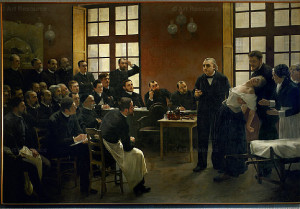

Movie Mole review of Augustine
The film is based on historical events involving the nineteenth-century French doctor Jean Martin Charcot, also known as the father of neurology, known for identifying and advancing the understanding of Multiple Sclerosis, Parkinson's disease, and Tourette's syndrome, as well as for helping to remove the influence of the church from French hospitals, and for having had a number of famous students, including Sigmund Freud. For many years Charcot was head of the Parisian public hospital Salpetriere, which housed large populations of poor women, imprisoned for madness, epilepsy, and most famously, hysteria. Charcot's treatment of hysteria became famous not only because he opened his Tuesday lectures to the public, offering demonstrations in which hypnosis was used to induce hysterical attacks, but also because the inmates of the hospital were extensively documented through published photographs.
Although the most famous of the Salpetriere's hysterics in the nineteenth century was the woman known as Blanche, shown swooning in a painting of one of Charcot's demonstrations, the best-known of the Salpetriere hysterics today is the young woman known as Augustine, whose images were taken up and celebrated by the surrealists, and have been discussed in a number of late twentieth century texts, including Georges Didi-Huberman's The Invention of Hysteria: Charcot and the Photographic Iconography of the Salpetriere, Elisabeth Bronfen's The Knotted Subject: Hysteria and its Discontents, and Asti Hustvedt's Medical Muses: Hysteria in Nineteenth-Century Paris.
Augustine's history is reported in somewhat divergent ways in different texts, but she appears to have arrived at the Salpetriere the same year as the use of photography. She was fourteen years old, and had been raped by the head of the house where she worked as a servant, and variously betrayed by her own family. She spent somewhere between five and twelve years at Salpetriere, finally escaping by disguising herself as a man.
Winocour's film opens with a shot of crabs flailing in a pot of hot water, perhaps a figure for the increasingly painful circumstances of the young housemaid Augustine (played by French pop singer Soko) in nineteenth-century Paris. Serving at table one evening, stared at by an insolent gentleman and ignored by the rest of the dinner guests, she succumbs to a seizure, and is taken off to the charity hospital Salpetriere, where she seems at first likely to continue to be neglected. But when the head doctor Charcot (played by Vincent Lindon) passes through the kitchen where she's been put to work, she has another quite dramatic fit, and is brought upstairs for further study. Stripped, diagrammed, poked with needles, hypnotized, she becomes one of Charcot's star hysterics, and is given her own room, and new clothes in which to have her public—and increasingly sexually suggestive—fits. Meanwhile, Charcot's wife Constance (played by Chiara Mastroianni) and subordinate Bourneville (played by Olivier Rabourdin) are working to insure further funding for Charcot's studies. Neglected while Charcot is away on a fundraising trip, Augustine refuses to eat until Charcot himself returns and spoons up her soup. Though Augustine repeatedly expresses her wish to be cured of her hysterical paralysis and other ailments, Charcot is mainly interested in using her as an object of study and of unacknowledged sexual titillation. After a burst of rebellion during a dress fitting sends Augustine running across the hospital grounds, she falls, and later wakes to find herself cured. When Charcot tries to hypnotize her again to impress a group of potential funders, she performs her hysteria while gazing at Charcot to indicate her conscious complicity, and later strides out of the hospital.


